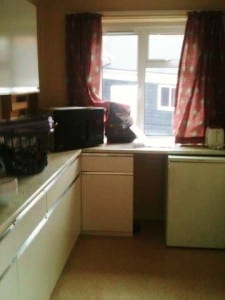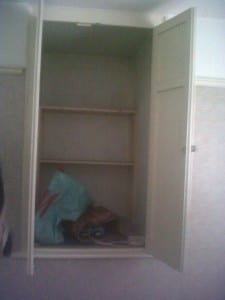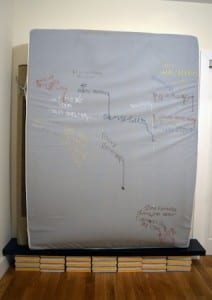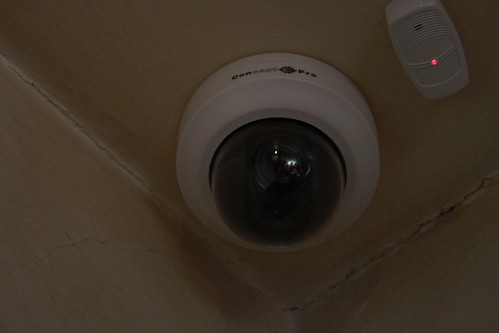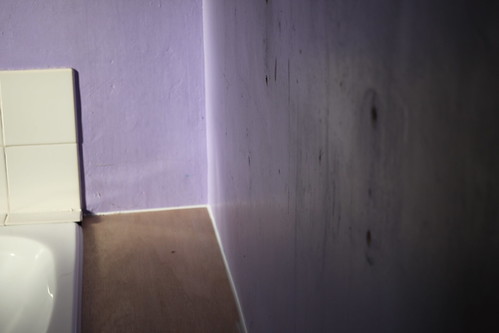Cupboards and “doors open onto an ever more private realm of intimate things” ((Heathcote, Edwin (2012) The Meaning Of Home, London: Frances Lincoln, p. 77)), and because of this unique quality they give you a chance to find a place to hide away, somewhere different faraway….and safe. On another plane, not quite belonging to a floor or area. Something not used just for storage of things, but also of memories, people and tears. This is what I found in our new house.
The cupboard in the bedroom instantly reminded me of my last home. An old bedroom. A walk in cupboard which housed the boiler…my favourite teddies. A place to play hide and seek, or a place to go and cry. Until five years ago it had always been my room.
I have one stand out memory of this hiding place. It’s not exactly pleasant, so I think that’s why the feel of the house triggered them.
I had been told off at school for talking during a Math lesson, and I remember getting home, getting into that space, and crying. In the space, I started to do maths wrong as a sort of punishment on purpose. It was a place where I could judge myself without being judged by my mum, or being a burden. I have never really cried in front of my mum, even to this day, because I thought (and indeed still think) that I had to be strong for her – to be a ‘big girl’ and help look after my brother because we were a single parent family.
Now the boiler is gone, and the room is no longer mine to claim…but it still feels like home to me.
To close the cupboard door and sit in silence was perfect, and something I still crave. Not necessarily a cupboard anymore, but just the darkness and a closed door. I got brought up to be independent, fiercely so. I didn’t have much of a choice – we moved around a bit, I helped raised my eldest younger brother, and I became my mum’s confidant. I had to be strong for her so never cried. I had to grow up quick.
So, sitting here in my cupboard in our house on West Parade, not quite in the darkness with the door open, the cupboard floods me with memories. Memories of crying where no-one else could see. A place of putting myself down. It’s the dark cupboard that let me cry and I’ll always be grateful.
A little place where I could go to be a child.
A place where, looking back, I developed my gratitude and strive for learning.
A place which shaped me.
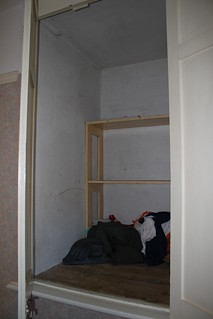 |
|
Taken by Jozey Wade, 3rd February 2013.
|
In this anti-space, I can see something quiet and personal being developed, something hidden that the audience has to find; a human installation. With personal experiences, transforming such a small space could be something very beautiful and touching, allowing “[our] past to surge into the present” ((McAuley quoted in Pearson, Mike (2010) Site-Specific Performance, Basingstoke: Palgrave Macmillan, p. 10)). The bedroom (and therefore , by extension, our cupboard) is “the most intimate, the most private and the most precious” ((Heathcote, Edwin (2012) The Meaning Of Home, London: Frances Lincoln., p. 71)) room in the house, so what happens if we both heightened and paradoxed these notions? If we created the bedroom to be safe and welcoming, almost of that of a childs, and the cupboard to expose the adult side of the bedroom. To have two highly polarized notions in such close proximity would create a powerful and contrasting performance, giving both audience members a completely different, and unique, experience.
When dealing with the cupboard, the bedroom and what lies there cannot be ignored. To fuse the two performance areas would make a stronger and more fulfilling performance. For example, when dealing with children; their imaginations, emotions, expectations and understanding of reality, you are allowed to bend the rules and break the conventions and restraints of social normality, so what happens if we took this notion and transfered it to the bedroom?
In the bedroom we get read fairy tales. We can all name at least one fairy tale or bedtime story I’m sure. However, with retrospect and looking at them through ‘adult’ eyes, we find hidden meanings, basic moral lessons, and sometimes things we don’t deem all that appropriate now we have experienced and lived within the adult world. A perfect example of this is the notion of the ‘Animal Groom’. Bettelheim puts forward the notion that “for love [to occur], a radical change in previously held attitudes about sex is absolutely unnecessary” and that “a common feature to [the fairy tales] is the sexual partner first experienced as an animal” ((Bettelheim, Bruno (1978[1991]) The Uses of Enchantment, London: Penguin Books, p. 282.)) becomes transformed into a, usually, handsome being. However, when viewed from an adult’s perspective it becomes disturbing: a woman committing bestiality and embedding the notion of being submissive and compliant within relationships from an early age.
It has become increasingly apparent that mixing adult themes into children’s literature appears to be as old as fairy tales and folklore itself. What happens if we make the literature, or the space, overtly adult? Would it still fall within the classifications of a fairy tale if lessons were learned the frame work complied. Could we argue that we are just modernising the literature? If the undertones of lost virginity and the exploration of the notion that “there are no longer any sexual secrets which must remain unknown” ((Bettelheim 1978, p. 308)), Beauty and the Beast would no longer be read as an innocent children’s story. If we were to transfer the adult side of the bedroom into the cupboard, but still make it apparent and blatantly obvious, would our bedroom still be considered safe? To create a narrative, played in the bedroom, but not in the bed, with adult intentions would be the epitome of this.
